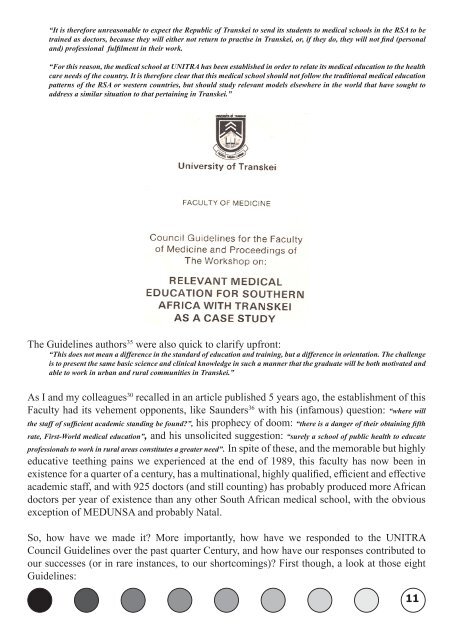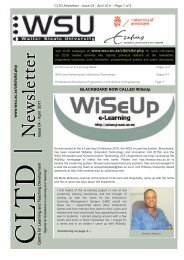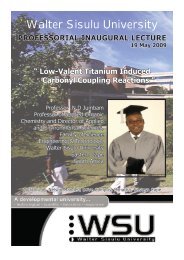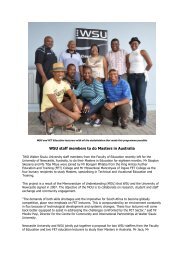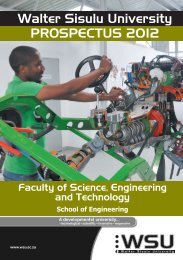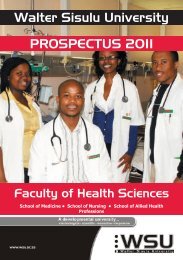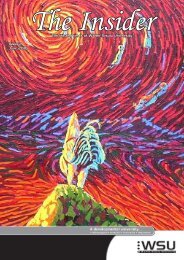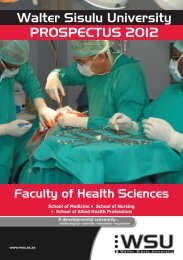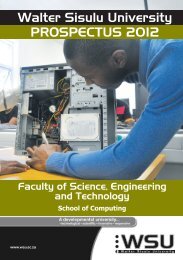25 years of training doctors at WSU: how - Walter Sisulu University
25 years of training doctors at WSU: how - Walter Sisulu University
25 years of training doctors at WSU: how - Walter Sisulu University
Create successful ePaper yourself
Turn your PDF publications into a flip-book with our unique Google optimized e-Paper software.
“It is therefore unreasonable to expect the Republic <strong>of</strong> Transkei to send its students to medical schools in the RSA to be<br />
trained as <strong>doctors</strong>, because they will either not return to practise in Transkei, or, if they do, they will not find (personal<br />
and) pr<strong>of</strong>essional fulfilment in their work.<br />
“For this reason, the medical school <strong>at</strong> UNITRA has been established in order to rel<strong>at</strong>e its medical educ<strong>at</strong>ion to the health<br />
care needs <strong>of</strong> the country. It is therefore clear th<strong>at</strong> this medical school should not follow the traditional medical educ<strong>at</strong>ion<br />
p<strong>at</strong>terns <strong>of</strong> the RSA or western countries, but should study relevant models elsewhere in the world th<strong>at</strong> have sought to<br />
address a similar situ<strong>at</strong>ion to th<strong>at</strong> pertaining in Transkei.”<br />
The Guidelines authors 35 were also quick to clarify upfront:<br />
“This does not mean a difference in the standard <strong>of</strong> educ<strong>at</strong>ion and <strong>training</strong>, but a difference in orient<strong>at</strong>ion. The challenge<br />
is to present the same basic science and clinical knowledge in such a manner th<strong>at</strong> the gradu<strong>at</strong>e will be both motiv<strong>at</strong>ed and<br />
able to work in urban and rural communities in Transkei.”<br />
As I and my colleagues30 recalled in an article published 5 <strong>years</strong> ago, the establishment <strong>of</strong> this<br />
Faculty had its vehement opponents, like Saunders36 with his (infamous) question: “where will<br />
the staff <strong>of</strong> sufficient academic standing be found?”, his prophecy <strong>of</strong> doom: “there is a danger <strong>of</strong> their obtaining fifth<br />
r<strong>at</strong>e, First-World medical educ<strong>at</strong>ion”, and his unsolicited suggestion: “surely a school <strong>of</strong> public health to educ<strong>at</strong>e<br />
pr<strong>of</strong>essionals to work in rural areas constitutes a gre<strong>at</strong>er need”. In spite <strong>of</strong> these, and the memorable but highly<br />
educ<strong>at</strong>ive teething pains we experienced <strong>at</strong> the end <strong>of</strong> 1989, this faculty has now been in<br />
existence for a quarter <strong>of</strong> a century, has a multin<strong>at</strong>ional, highly qualified, efficient and effective<br />
academic staff, and with 9<strong>25</strong> <strong>doctors</strong> (and still counting) has probably produced more African<br />
<strong>doctors</strong> per year <strong>of</strong> existence than any other South African medical school, with the obvious<br />
exception <strong>of</strong> MEDUNSA and probably N<strong>at</strong>al.<br />
So, <strong>how</strong> have we made it? More importantly, <strong>how</strong> have we responded to the UNITRA<br />
Council Guidelines over the past quarter Century, and <strong>how</strong> have our responses contributed to<br />
our successes (or in rare instances, to our shortcomings)? First though, a look <strong>at</strong> those eight<br />
Guidelines:<br />
11


